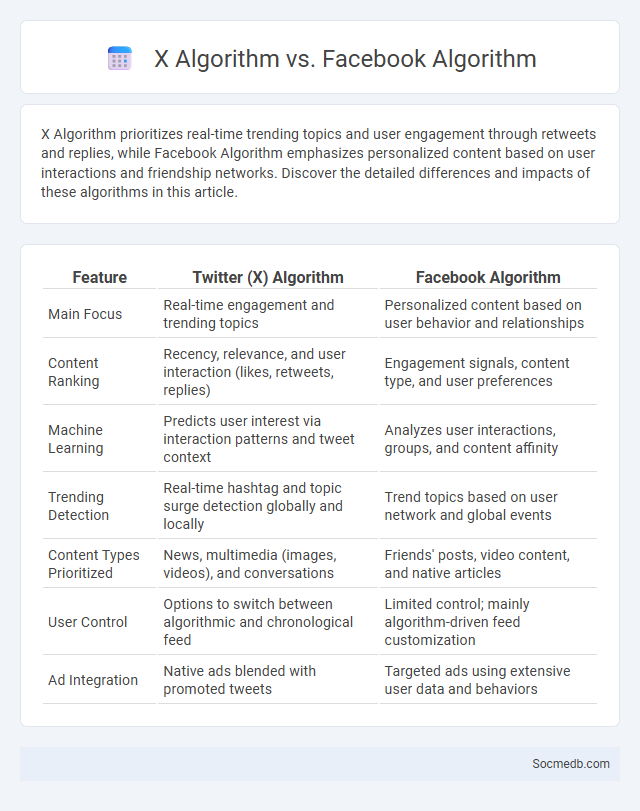
Photo illustration: X Algorithm vs Facebook Algorithm
X Algorithm prioritizes real-time trending topics and user engagement through retweets and replies, while Facebook Algorithm emphasizes personalized content based on user interactions and friendship networks. Discover the detailed differences and impacts of these algorithms in this article.
Table of Comparison
| Feature | Twitter (X) Algorithm | Facebook Algorithm |
|---|---|---|
| Main Focus | Real-time engagement and trending topics | Personalized content based on user behavior and relationships |
| Content Ranking | Recency, relevance, and user interaction (likes, retweets, replies) | Engagement signals, content type, and user preferences |
| Machine Learning | Predicts user interest via interaction patterns and tweet context | Analyzes user interactions, groups, and content affinity |
| Trending Detection | Real-time hashtag and topic surge detection globally and locally | Trend topics based on user network and global events |
| Content Types Prioritized | News, multimedia (images, videos), and conversations | Friends' posts, video content, and native articles |
| User Control | Options to switch between algorithmic and chronological feed | Limited control; mainly algorithm-driven feed customization |
| Ad Integration | Native ads blended with promoted tweets | Targeted ads using extensive user data and behaviors |
Introduction to X Algorithm, Facebook Algorithm, and Algorithmic Timeline
The X algorithm prioritizes personalized content by analyzing user interactions and preferences to optimize engagement. Facebook's algorithm uses machine learning to rank posts based on factors such as relevance, timeliness, and user interests, enhancing content visibility in News Feeds. The algorithmic timeline organizes social media updates dynamically, tailoring the order of content presentation to maximize user retention and satisfaction.
Understanding Social Media Algorithms: An Overview
Social media algorithms use machine learning and user interaction data to personalize content feeds, prioritizing posts based on relevance and engagement metrics such as likes, shares, and comments. Platforms like Facebook, Instagram, and TikTok continuously update their algorithms to enhance user experience by promoting content that keeps users engaged longer. Understanding these algorithms helps marketers optimize content strategies, boost organic reach, and improve audience targeting.
Key Differences Between X Algorithm and Facebook Algorithm
X Algorithm prioritizes real-time trending topics and user engagement metrics such as retweets, likes, and replies to surface popular and relevant content quickly. Facebook Algorithm emphasizes personalized content delivery by analyzing user interactions, interests, and network connections to increase meaningful social interactions and time spent on the platform. Unlike Facebook's focus on community and relationship building, X leverages immediacy and virality to drive content visibility and user participation.
How Algorithmic Timelines Shape User Experience
Algorithmic timelines on social media platforms prioritize content based on user interaction, engagement rates, and behavioral data, shaping personalized browsing experiences. These algorithms analyze factors such as likes, shares, comments, and watch time to deliver relevant posts, enhancing user retention and satisfaction. However, this selective content curation can create echo chambers and filter bubbles, influencing perceptions and limiting exposure to diverse viewpoints.
Content Ranking Factors: X vs. Facebook
Content ranking factors on X prioritize recency and engagement speed, making timely, viral posts more visible to Your audience. Facebook emphasizes relevance and meaningful interactions, factoring in time spent on content and relationships between users. Understanding these differences allows for tailored strategies to maximize visibility and engagement on each platform.
Impact on Organic Reach: A Comparative Analysis
Organic reach on social media platforms has significantly declined due to algorithm changes prioritizing paid content and user interactions. Facebook's organic reach dropped by over 50% since 2016, while Instagram's algorithm favors engagement metrics, reducing visibility for non-promoted posts. Comparative analysis reveals that platforms emphasizing user engagement and advertising revenue models tend to restrict organic content distribution more aggressively.
User Engagement: Which Algorithm Delivers Better Results?
Social media platforms utilize various algorithms to maximize user engagement by tailoring content to individual preferences, with machine learning-based algorithms showing superior performance in predicting user interests. Algorithms like Facebook's EdgeRank and TikTok's recommendation engine leverage real-time data and interaction patterns to prioritize content that encourages likes, shares, and comments, resulting in higher engagement rates. Platforms that continuously update algorithms using AI-driven analytics report increased time spent on-site and more frequent user interactions compared to rule-based or chronological feed algorithms.
Transparency and User Control in Algorithmic Feeds
Transparency in algorithmic feeds enhances user trust by clearly explaining how content is selected and prioritized. Providing user control tools, such as customizable filters and feed preferences, empowers individuals to tailor their social media experience. Algorithmic transparency combined with user agency reduces misinformation spread and promotes a more authentic digital interaction environment.
Challenges and Criticisms of Algorithmic Timelines
Algorithmic timelines on social media platforms often lead to echo chambers by prioritizing content that aligns with Your existing beliefs, which can limit exposure to diverse perspectives and reinforce biases. These algorithms may also contribute to misinformation spread by amplifying sensational or controversial content for higher engagement. Privacy concerns arise as platforms collect extensive user data to fine-tune timelines, raising questions about data security and user consent.
Future Trends: The Evolution of Social Media Algorithms
Social media algorithms are increasingly leveraging artificial intelligence and machine learning to deliver hyper-personalized content, enhancing user engagement through predictive analytics. Emerging trends highlight the integration of real-time data processing and augmented reality features, transforming user interaction and content discovery. Privacy-focused algorithm updates aim to balance personalization with data security, responding to growing regulatory demands and user awareness.
 socmedb.com
socmedb.com